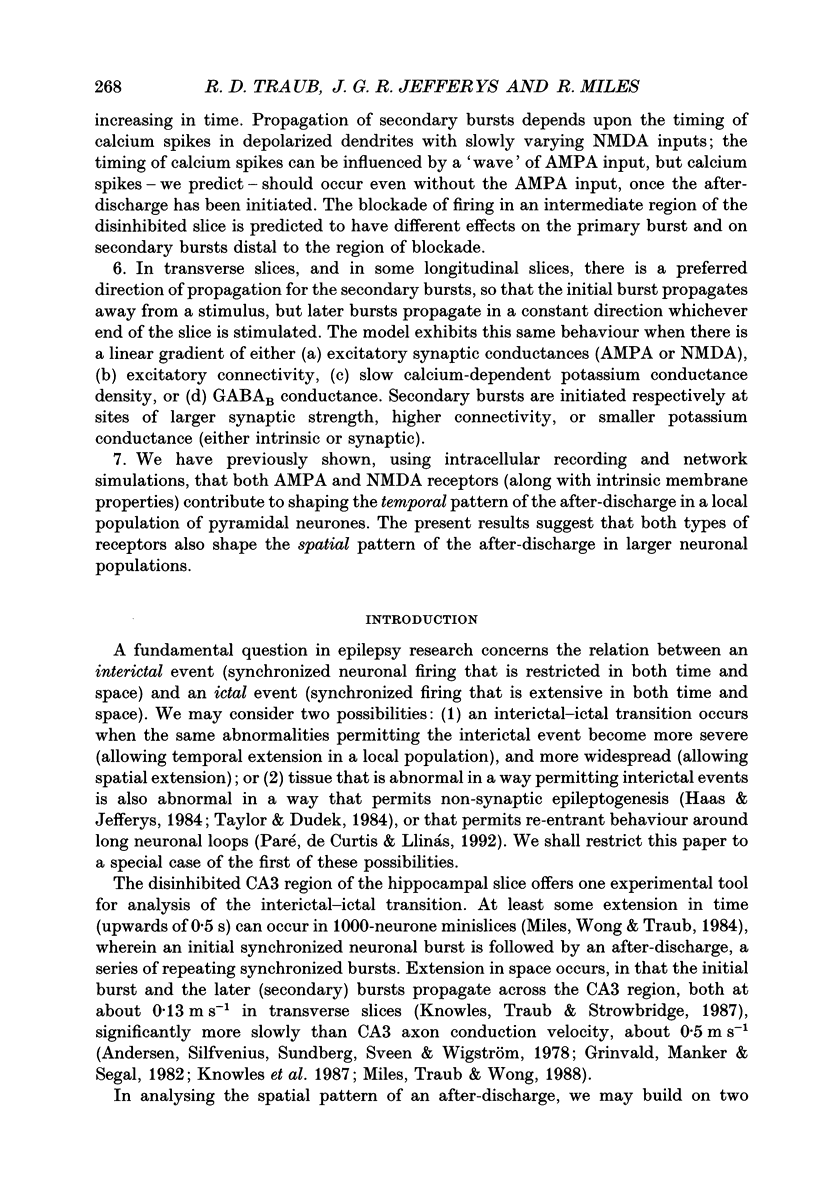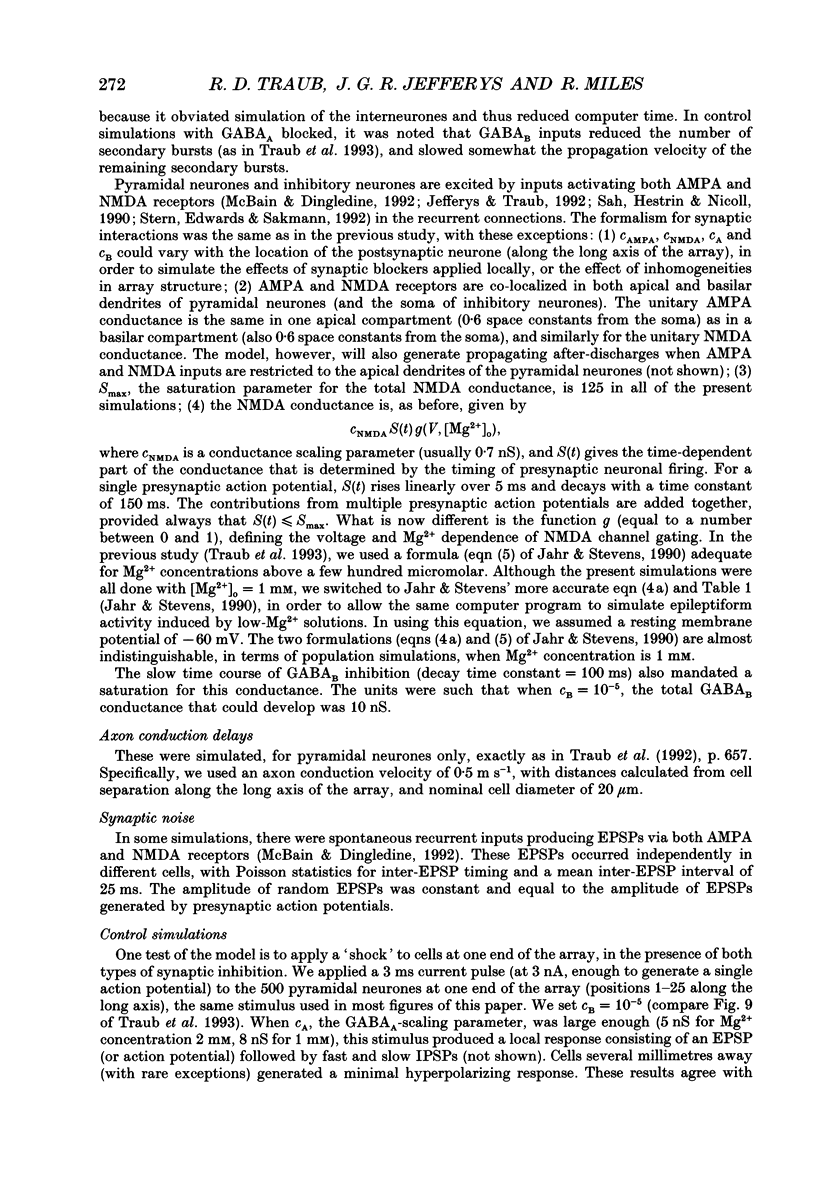Abstract
1. A model has been proposed of picrotoxin-induced hippocampal in vitro after-discharges; it depends critically upon alpha-amino-3-hydroxy-5-methyl-4-isoxazole propionic acid (AMPA) and N-methyl-D-aspartate (NMDA) receptors in the recurrent excitatory connections between pyramidal neurones, and upon the ability of pyramidal neurones to generate bursts at about 10 Hz when their dendrites are sufficiently depolarized. 2. We study here the question of whether this model can account for spatial--as well as temporal--aspects of after-discharges in guinea-pig hippocampal slices. For example, can the model explain the propagation along a transverse slice of the initial burst and the secondary bursts at about the same velocity, approximately 0.10-0.20 m s-1? Under what conditions might the secondary bursts exhibit a different spatial pattern to the initial burst, as we now show can occur in longitudinal slices? To examine these questions, we increased the number of cells in our model from 100 to 8000 (in a 20 x 400 array), arranging the excitatory synaptic connections in a spatially restricted fashion, with an average extent of 1.0 mm (as suggested experimentally). 3. Our model suggests that both AMPA and NMDA receptors contribute to the propagation pattern and velocity of the initial and the secondary bursts in an after-discharge. 4. When unitary AMPA and NMDA conductances are in the range where the primary burst lasts for 100-200 ms, and there are three or four secondary bursts, then both primary and secondary bursts propagate near to the experimentally observed velocity for transverse slices. In the model, however, secondary bursts propagate at somewhat slower velocities than the initial burst. 5. The mechanisms of propagation are different for the initial and for the secondary bursts: propagation of the primary burst depends upon the initiation of electrogenesis in 'resting' dendrites by AMPA and NMDA inputs that are rapidly increasing in time. Propagation of secondary bursts depends upon the timing of calcium spikes in depolarized dendrites with slowly varying NMDA inputs; the timing of calcium spikes can be influenced by a 'wave' of AMPA input, but calcium spikes--we predict--should occur even without the AMPA input, once the after-discharge has been initiated. The blockade of firing in an intermediate region of the disinhibited slice is predicted to have different effects on the primary burst and on secondary bursts distal to the region of blockade.(ABSTRACT TRUNCATED AT 400 WORDS)
Full text
PDF




















Selected References
These references are in PubMed. This may not be the complete list of references from this article.
- Andersen P., Silfvenius H., Sundberg S. H., Sveen O., Wigström H. Functional characteristics of unmyelinated fibres in the hippocampal cortex. Brain Res. 1978 Apr 7;144(1):11–18. doi: 10.1016/0006-8993(78)90431-6. [DOI] [PubMed] [Google Scholar]
- Bragdon A. C., Taylor D. M., Wilson W. A. Potassium-induced epileptiform activity in area CA3 varies markedly along the septotemporal axis of the rat hippocampus. Brain Res. 1986 Jul 16;378(1):169–173. doi: 10.1016/0006-8993(86)90300-8. [DOI] [PubMed] [Google Scholar]
- Chervin R. D., Pierce P. A., Connors B. W. Periodicity and directionality in the propagation of epileptiform discharges across neocortex. J Neurophysiol. 1988 Nov;60(5):1695–1713. doi: 10.1152/jn.1988.60.5.1695. [DOI] [PubMed] [Google Scholar]
- Christian E. P., Dudek F. E. Characteristics of local excitatory circuits studied with glutamate microapplication in the CA3 area of rat hippocampal slices. J Neurophysiol. 1988 Jan;59(1):90–109. doi: 10.1152/jn.1988.59.1.90. [DOI] [PubMed] [Google Scholar]
- Davies C. H., Davies S. N., Collingridge G. L. Paired-pulse depression of monosynaptic GABA-mediated inhibitory postsynaptic responses in rat hippocampus. J Physiol. 1990 May;424:513–531. doi: 10.1113/jphysiol.1990.sp018080. [DOI] [PMC free article] [PubMed] [Google Scholar]
- Dichter M., Spencer W. A. Penicillin-induced interictal discharges from the cat hippocampus. I. Characteristics and topographical features. J Neurophysiol. 1969 Sep;32(5):649–662. doi: 10.1152/jn.1969.32.5.649. [DOI] [PubMed] [Google Scholar]
- Domann R., Uhlig S., Dorn T., Witte O. W. Participation of interneurons in penicillin-induced epileptic discharges. Exp Brain Res. 1991;83(3):683–686. doi: 10.1007/BF00229848. [DOI] [PubMed] [Google Scholar]
- Finch D. M., Nowlin N. L., Babb T. L. Demonstration of axonal projections of neurons in the rat hippocampus and subiculum by intracellular injection of HRP. Brain Res. 1983 Jul 25;271(2):201–216. doi: 10.1016/0006-8993(83)90283-4. [DOI] [PubMed] [Google Scholar]
- Grinvald A., Manker A., Segal M. Visualization of the spread of electrical activity in rat hippocampal slices by voltage-sensitive optical probes. J Physiol. 1982 Dec;333:269–291. doi: 10.1113/jphysiol.1982.sp014453. [DOI] [PMC free article] [PubMed] [Google Scholar]
- Haas H. L., Jefferys J. G. Low-calcium field burst discharges of CA1 pyramidal neurones in rat hippocampal slices. J Physiol. 1984 Sep;354:185–201. doi: 10.1113/jphysiol.1984.sp015371. [DOI] [PMC free article] [PubMed] [Google Scholar]
- Ishizuka N., Weber J., Amaral D. G. Organization of intrahippocampal projections originating from CA3 pyramidal cells in the rat. J Comp Neurol. 1990 May 22;295(4):580–623. doi: 10.1002/cne.902950407. [DOI] [PubMed] [Google Scholar]
- Jahr C. E., Stevens C. F. Voltage dependence of NMDA-activated macroscopic conductances predicted by single-channel kinetics. J Neurosci. 1990 Sep;10(9):3178–3182. doi: 10.1523/JNEUROSCI.10-09-03178.1990. [DOI] [PMC free article] [PubMed] [Google Scholar]
- Jefferys J. G. Chronic epileptic foci in vitro in hippocampal slices from rats with the tetanus toxin epileptic syndrome. J Neurophysiol. 1989 Aug;62(2):458–468. doi: 10.1152/jn.1989.62.2.458. [DOI] [PubMed] [Google Scholar]
- Jones R. S., Lambert J. D. Synchronous discharges in the rat entorhinal cortex in vitro: site of initiation and the role of excitatory amino acid receptors. Neuroscience. 1990;34(3):657–670. doi: 10.1016/0306-4522(90)90172-z. [DOI] [PubMed] [Google Scholar]
- Knowles W. D., Traub R. D., Strowbridge B. W. The initiation and spread of epileptiform bursts in the in vitro hippocampal slice. Neuroscience. 1987 May;21(2):441–455. doi: 10.1016/0306-4522(87)90134-5. [DOI] [PubMed] [Google Scholar]
- Lee W. L., Hablitz J. J. Effect of APV and ketamine on epileptiform activity in the CA1 and CA3 regions of the hippocampus. Epilepsy Res. 1990 Jul;6(2):87–94. doi: 10.1016/0920-1211(90)90082-7. [DOI] [PubMed] [Google Scholar]
- Lee W. L., Hablitz J. J. Involvement of non-NMDA receptors in picrotoxin-induced epileptiform activity in the hippocampus. Neurosci Lett. 1989 Dec 15;107(1-3):129–134. doi: 10.1016/0304-3940(89)90804-5. [DOI] [PubMed] [Google Scholar]
- McBain C., Dingledine R. Dual-component miniature excitatory synaptic currents in rat hippocampal CA3 pyramidal neurons. J Neurophysiol. 1992 Jul;68(1):16–27. doi: 10.1152/jn.1992.68.1.16. [DOI] [PubMed] [Google Scholar]
- Miles R. Synaptic excitation of inhibitory cells by single CA3 hippocampal pyramidal cells of the guinea-pig in vitro. J Physiol. 1990 Sep;428:61–77. doi: 10.1113/jphysiol.1990.sp018200. [DOI] [PMC free article] [PubMed] [Google Scholar]
- Miles R., Traub R. D., Wong R. K. Spread of synchronous firing in longitudinal slices from the CA3 region of the hippocampus. J Neurophysiol. 1988 Oct;60(4):1481–1496. doi: 10.1152/jn.1988.60.4.1481. [DOI] [PubMed] [Google Scholar]
- Miles R., Wong R. K., Traub R. D. Synchronized afterdischarges in the hippocampus: contribution of local synaptic interactions. Neuroscience. 1984 Aug;12(4):1179–1189. doi: 10.1016/0306-4522(84)90012-5. [DOI] [PubMed] [Google Scholar]
- Numann R. E., Wadman W. J., Wong R. K. Outward currents of single hippocampal cells obtained from the adult guinea-pig. J Physiol. 1987 Dec;393:331–353. doi: 10.1113/jphysiol.1987.sp016826. [DOI] [PMC free article] [PubMed] [Google Scholar]
- Numann R. E., Wong R. K. Voltage-clamp study on GABA response desensitization in single pyramidal cells dissociated from the hippocampus of adult guinea pigs. Neurosci Lett. 1984 Jun 29;47(3):289–294. doi: 10.1016/0304-3940(84)90528-7. [DOI] [PubMed] [Google Scholar]
- Paré D., deCurtis M., Llinás R. Role of the hippocampal-entorhinal loop in temporal lobe epilepsy: extra- and intracellular study in the isolated guinea pig brain in vitro. J Neurosci. 1992 May;12(5):1867–1881. doi: 10.1523/JNEUROSCI.12-05-01867.1992. [DOI] [PMC free article] [PubMed] [Google Scholar]
- Pitler T. A., Alger B. E. Postsynaptic spike firing reduces synaptic GABAA responses in hippocampal pyramidal cells. J Neurosci. 1992 Oct;12(10):4122–4132. doi: 10.1523/JNEUROSCI.12-10-04122.1992. [DOI] [PMC free article] [PubMed] [Google Scholar]
- Sah P., Hestrin S., Nicoll R. A. Properties of excitatory postsynaptic currents recorded in vitro from rat hippocampal interneurones. J Physiol. 1990 Nov;430:605–616. doi: 10.1113/jphysiol.1990.sp018310. [DOI] [PMC free article] [PubMed] [Google Scholar]
- Stern P., Edwards F. A., Sakmann B. Fast and slow components of unitary EPSCs on stellate cells elicited by focal stimulation in slices of rat visual cortex. J Physiol. 1992 Apr;449:247–278. doi: 10.1113/jphysiol.1992.sp019085. [DOI] [PMC free article] [PubMed] [Google Scholar]
- Tamamaki N., Watanabe K., Nojyo Y. A whole image of the hippocampal pyramidal neuron revealed by intracellular pressure-injection of horseradish peroxidase. Brain Res. 1984 Jul 30;307(1-2):336–340. doi: 10.1016/0006-8993(84)90489-x. [DOI] [PubMed] [Google Scholar]
- Taylor C. P., Dudek F. E. Synchronization without active chemical synapses during hippocampal afterdischarges. J Neurophysiol. 1984 Jul;52(1):143–155. doi: 10.1152/jn.1984.52.1.143. [DOI] [PubMed] [Google Scholar]
- Thompson S. M., Gähwiler B. H. Activity-dependent disinhibition. I. Repetitive stimulation reduces IPSP driving force and conductance in the hippocampus in vitro. J Neurophysiol. 1989 Mar;61(3):501–511. doi: 10.1152/jn.1989.61.3.501. [DOI] [PubMed] [Google Scholar]
- Traub R. D., Miles R., Buzsáki G. Computer simulation of carbachol-driven rhythmic population oscillations in the CA3 region of the in vitro rat hippocampus. J Physiol. 1992;451:653–672. doi: 10.1113/jphysiol.1992.sp019184. [DOI] [PMC free article] [PubMed] [Google Scholar]
- Traub R. D., Miles R., Jefferys J. G. Synaptic and intrinsic conductances shape picrotoxin-induced synchronized after-discharges in the guinea-pig hippocampal slice. J Physiol. 1993 Feb;461:525–547. doi: 10.1113/jphysiol.1993.sp019527. [DOI] [PMC free article] [PubMed] [Google Scholar]
- Traub R. D. Simulation of intrinsic bursting in CA3 hippocampal neurons. Neuroscience. 1982 May;7(5):1233–1242. doi: 10.1016/0306-4522(82)91130-7. [DOI] [PubMed] [Google Scholar]
- Traub R. D., Wong R. K., Miles R., Michelson H. A model of a CA3 hippocampal pyramidal neuron incorporating voltage-clamp data on intrinsic conductances. J Neurophysiol. 1991 Aug;66(2):635–650. doi: 10.1152/jn.1991.66.2.635. [DOI] [PubMed] [Google Scholar]
- Williams T. L. Phase coupling by synaptic spread in chains of coupled neuronal oscillators. Science. 1992 Oct 23;258(5082):662–665. doi: 10.1126/science.1411575. [DOI] [PubMed] [Google Scholar]


